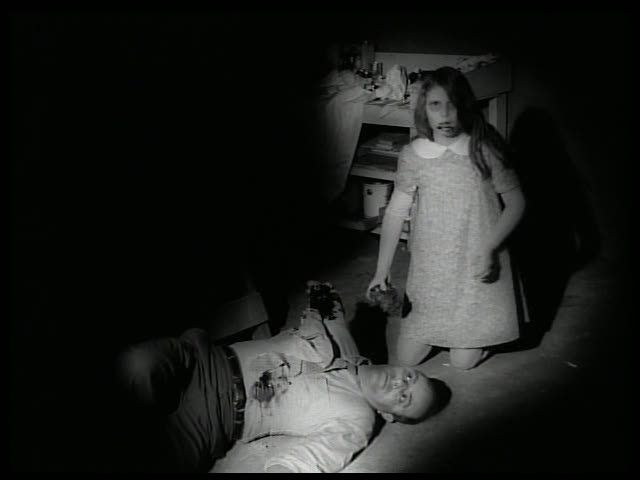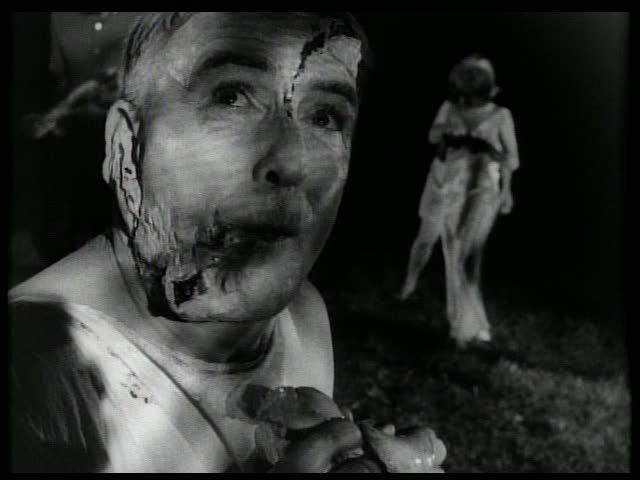
Night of the Living Dead was George Romero's first film, and remains an enduring classic of the zombie genre: a raw, roughly made effort that transcends its low-budget origins. It's an uncompromising, brutal film, from its tense, moody opening to the casually bloody irony of its conclusion. Its depiction of the zombie menace is unsettling as much for what it brings out in humanity as for the body count racked up by the walking dead. Indeed, as many people are killed in this film by other unaffected people, by accidents and the violence of people under stress, as are killed by the zombies themselves. The zombie infestation is a swift, virulent plague that destabilizes human society, revealing just how precarious and fragile our social institutions are, just how easily the appearance of order is disrupted. The government has a tidy explanation for the zombies — mysterious nuclear energy from space — and hands out constant assurances that everything is under control, that the problem is being dealt with. And yet the appearance of these living dead monsters, spreading across half the country in but a few hours, throws everything into chaos.
Romero explores this loss of social order through a kind of microcosm of society, clustered together in an abandoned house in the middle of an empty rural area. Here, with no one else living around for miles, a small group of survivors comes together under one roof. In the harrowing opening scenes, Barbra (Judith O'Dea) and her brother Johnny (Russell Streiner) are visiting their father's grave when they see a strange man wandering around the cemetery. As they are leaving, the man attacks them, killing Johnny as Barbra frantically flees, first in her car and then on foot, finally coming across the old empty house. These opening scenes must surely rank among the greatest and most iconic sequences in horror cinema. The mood of the opening is eerie and unsettling even before the first zombie attack, with Romero slowly setting up what's to come, lingering on the loving, affectionately joking relationship between the siblings even though one of them is soon to die. Throughout the scene, as Barbra and Johnny place flowers on their father's grave and Barbra prays, to Johnny's impatience, the zombie can be glimpsed stumbling around in the far background of the shot, an ominous presence — we know the name of the film, we know what's coming even if Barbra and Johnny don't. Romero lets things build subtly, and then films Barbra's desperate escape with a jittery, bouncing camera that falls to the ground, skewed at an eccentric angle, when Barbra falls, and shakes nervously as she runs, her features blurred with fear and despair. The zombie doesn't look like much — a slightly strange-looking old Boris Karloff type — but the sequence is sheer terror anyway.
Once inside the house, the film settles down into a meandering, static middle section as the stunned, delirious Barbra comes under the protection of a young black man, Ben (Duane Jones), who soon drives up in a truck that's run out of gas. Ben fortifies the house by barring the windows with wood, and holds off the zombies with fire and a shotgun he finds in one of the house's closets. He also discovers a small group of other survivors hiding in the basement: the bitter control freak Harry (Karl Hardman), his wife (Marilyn Eastman) and injured daughter (Kyra Schon), and an attractive young couple (Keith Wayne and Judith Ridley) who had been just passing through when the zombies first appeared. The dynamic among this group soon becomes the focus of the film, as the zombies hover outside, kept at bay for a time by the fires set by Ben. The zombies soon begin to seem like less of a threat than the internal strife within the group, their terror overriding their ordinary impulses and setting them against each other. Ben naturally assumes leadership, which causes conflict with Harry over the best course of action. Though the group is able to work together and make plans in sporadic bursts, the arguments amongst them constantly threaten to boil over, bringing out angry, ugly feelings.

If this film is Romero's view of social structures, it's an especially bleak one. The film presents two options — Harry's insistence that they barricade themselves in the house's basement and Ben's desire to remain upstairs — and seems to ask the audience to side with one or the other, to decide who's right. Certainly, Ben has the upper hand morally: he's interested in the survival of the whole group and wants them all to work together, while the self-interested Harry refuses to even investigate when he hears screams upstairs. Romero places the audience's sympathies squarely on Ben, making him a strong, forceful hero — which makes it all the more shocking when, in the second half of the film, Ben's inept leadership splinters the group, leading directly to several deaths and the cascading tragedies of the denouement. Romero cleverly sets up Ben as an audience surrogate, the only character in the film who seems to be smart and in control, only to tear him down, to destroy his control, to reveal his goodness and strength as illusory when subjected to the destruction of the overall social order. The film's message is simple, and astoundingly negative: the line between humanity and animalistic horror is thin and easily crossed.
The film's middle section in the house is essential to this point, but with the zombies mostly unseen outside, long stretches are given over to tiresome monologues and repetitive arguments, as well as dry, over-long snatches of TV news. Romero's occasional cutaways to the zombies outside are welcome, particularly a haunting sequence of the zombies settling down to eat, gnawing at human bones and picking up stringy entrails from the grass. Within the house, the conflicts are obvious, and quickly established, so the multiple conversations going over the same ground just feel like padding after a while. Even more unnecessary is the way Romero has Barbra repeat, at great length, a fractured account of the events from the opening scenes — which Romero of course captured so vividly and unforgettably that Barbra's ranting monologue is wholly redundant. Despite the occasional lagging moment in the film's middle, its resolution is harrowing and terrifying, a rapidly spiraling descent into chaos and violence. The zombies, with their crudely caked makeup and lumbering walk, finally invade the house, and the ensuing madness is captured with a rough, ragged aesthetic that fully conveys the loss of safety and security as the marauding creatures break through the boarded-up windows and doors. It all heads towards a deeply unsettling and ambivalent conclusion: the zombies are defeated, the crisis subdued, but the whole incident seems to have unpeeled several layers of society, revealing ugly truths beneath the surface.
I first saw this film in 1970 as a high-school student, recommended by my zany horror-film-loving English teacher, who himself wrote channibalistic horror stories. It remains today unforgettable, even with the subsequent re-viewings of the film in a revival house at midnight and on DVD. The most unsettling thing about this seminal gorefest of course was the way it ended, with Jones being gunned down after his grueling ordeal, and subsequenting being hung on meat hooks in the illustrated ending along with the rest of the slaughtered flesh eaters.
ReplyDeleteThe film's hokey dialogue (most of it spoken by Harry) has huge camp-appeal, but I always found it ironic that Harry the coward (by wanting to barricade hiumself in the basement) was really the one who was right all along.
I appreciated reading your succinct analogies of Romero's satirical barbs at society and (bleak) social structures, much as it's sequel was an attack on consumerism. But again, some of your sentences are just so marvelous, so beautifully and insightfully crafted. Here's one near the end:
"The zombies, with their crudely caked makeup and lumbering walk, finally invade the house, and the ensuing madness is captured with a rough, ragged aesthetic that fully conveys the loss of safety and security as the marauding creatures break through the boarded-up windows and doors."
Frankly, this review of NIGHT OF THE LIVING DEAD is the best one I have ever read, indeed it may well be the best one out there period.
Those two stills by the way, are really ghoulish! Nightmare inducing! LOL!
ReplyDelete